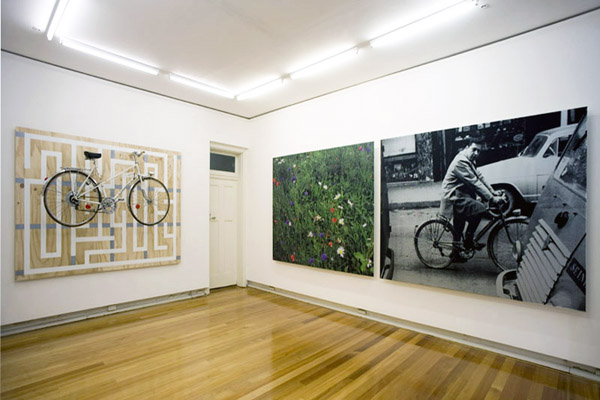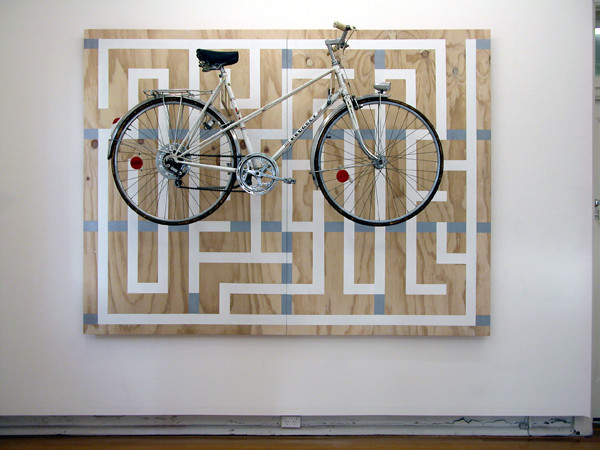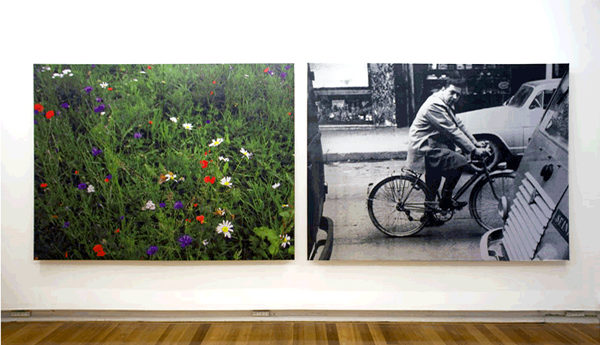
Exhibition
Artwork Title: Untitled
Material: acrylic and Peugeot bicycle on plywood, digital print, screenprint on canvas
Dimension: each piece 180 x 240 cm
Year: 2007
Location: Peloton, Sydney


Labyrinth based on plan for Freie Universität Berlin, Candilis-Josic-Woods, 1963, with Peugeot bicycle/ a field of Spring wildflowers in Munster / Shadrach Woods on a Parisian street riding one of the (Peugeot) bicycles owned by the Candilis-Josic-Woods office
Notes for an exhibition
In Germany and Australia, Richard Dunn has shown works of painting, installation and photography, that reflect on spaces and things in the urban environment and its no less cultivated mirror in open ‘natural’ space. The nature of the city and of ‘public’ space, or space for people, are the focus for work which raises open questions rather provides a logic of response. This approach, using a variety of technical means to approach an idea, is typical over a number of decades, yet all this work is in the present. The show at Peleton puts together photographed images that make reference to Team 10 – the international architectural group that included Aldo van Eyck in Amsterdam, Peter and Alison Smithson in London and Candilis-Josic-Woods in Paris. Shadrach Woods is photographed on an office bicycle in a Paris street. He said, “The structure of the city lies not in its geometry, but in the human activities within it.”. This show is one of those activities.
RD 2007
x\\x\\\Shadrach Woods(1923-1973)
Shadrach William Woods was born in Yonkers, New York on 30 June 1923. After the Second World War, in 1945, Woods went to Trinity College in Dublin to read literature and philosophy, whereas initially he had trained as an engineer. In 1948 he decided to turn to architecture and applied for a job at the office of Le Corbusier in Paris. It was Georges Candilis who employed and guided Shadrach Woods as an architect in the office. Together, Candilis and Woods finalized the design concept of the Unité d’abitation and subsequently became the project architects for the construction of the well-known Unité in Marseilles (1945-52). In 1951 Woods became the leader of ATBAT-Afrique in Tangiers in Morocco, together with Candilis and engineer Henri Piot. This African branch of ATBAT, Atelier des b√¢tisseurs, founded in 1947 by Le Corbusier, Vladimir Bodiansky and Andr√© Wogenscky, was conceived as a research centre, where architects, engineers and technicians could work in an interdisciplinary fashion. Due to the tense political climate the ATBAT-Afrique office in Tangiers was closed at the end of 1952, which made Woods and Candilis the leaders of the enlarged Casablanca head-office. However, the changed atmosphere in Morocco announced the end of ATBAT-Afrique. Candilis and Woods returned to France in 1954 and opened their own office together with Alexis Josic. In the same year they won the national competition Operation Million for low cost housing. This resulted in assignments for several tens of thousands of dwellings in France and in the French overseas territories. Within the Candilis-Josic-Woods office Woods had the role of theoretician. He conceptually elaborated the working methods and designs of the partnership in noteworthy articles such as “Stem”(1960) and “Web” (1962). He was also the architect in charge of notorious projects such as the design for Frankfurt-R√∂merberg (1963) and the Berlin Free University (together with Manfred Schiedhelm, 1963-73).
Wihin Team 10 Woods was one of the most theoretically oriented contributors, who relentlessly positioned architecture in its historical, social and cultural matrix. This orientation resulted in a close relationship with Alison and Peter Smithson. Due to his French language skills Woods also maintained good contacts with the South Europeans within the Team 10 circle, especially Giancarlo De Carlo. De Carlo invited Woods to contribute to the Milan Triennale in 1968. Under the main header Urbanism is Everybody’s Business, Woods and his assistant Joachim Pfeufer designed a remarkable installation that situated the projects of Candilis-Josic-Woods within broader reflections on natural resources, pollution, participation, etcetera. The installation was never seen by the large public due to a sit-in that prevented the Triennale from opening. Next to Urbanism is Everybody’s Business, Woods published his ideas in What U Can Do (1970), and in The Man in the Street (posthumously published in 1975).
Shadrach Woods lectured at Yale University (New Haven, USA) in 1967. He was professor of Architecture at the Harvard Graduate School of Design (Cambridge (Mass.), USA, 1968-73) and visiting professor at several other schools in the United States and abroad.
After the break-up of the Candilis-Josic-Woods partnership in 1969, Woods continued his work as an architect and especially as urban planner in his office in New York, together with several partners until his death in 1973. The Redevelopment Plan for the SoHo District in New York (1969), the Redevelopment Plan for Karslruhe (Germany, 1970) and the project for Douglas Circle (Central Park, New York, 1970) are his best-known designs from this period.
Shadrach Woods died in New York on 31 July 1973.